Exploring a Silent City: Excavation and Analysis of the
Holmes-Vardeman-Stephenson Cemetery, Lincoln County, Kentucky
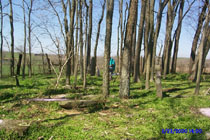 |
|
Holmes, Vardeman, Stephenson Cemetery prior to
excavation. |
Donald
W. Linebaugh, Ph.D. and Shawn Phillips, University of Kentucky
Program for Archaeological Research
Presented at the Eighteenth Annual Kentucky Heritage Council
Archaeological Conference, March 4, 2001
The
cemetery, or silent city, is a ubiquitous landscape feature that
houses the dead across both time and space. While death has been
called the great equalizer of humankind, the rituals associated
with death and dying are replete with social, economic, and even
political messages and symbols. Views of death have varied
greatly across the ages. For example, early Americans held
deeply rooted attitudes about death, heaven, and hell that were
structured around Christian doctrine and medieval superstition.
In the late 18th century, enlightenment ideology and reformation
theology brought about a shift in the prevailing view of death.
To the enlightened, nature and nature's laws defined man's place
in the universe and if the natural order could be understood
then man could eventually comprehend and even manipulate death.
This emphasis on scientific naturalism is apparent in the rural
cemetery movement in the early 19th century and in the design
and inscriptions of gravestones and memorials of the period.
Although the rural cemetery movement has been studied from many
disciplinary perspectives, the thousands of smaller family and
community cemeteries scattered across the landscape have
received much less attention. Yet, these small rural cemeteries
have the potential to speak to a host of important research
issues. It is in this context that the
Holmes-Vardeman-Stephenson cemetery holds a great deal of
promise for understanding rural 19th-century Kentucky.
Archaeological fieldwork at the Holmes-Vardeman-Stephenson
Cemetery was completed in July 2000. The project, undertaken to
fulfill obligations for a U.S. Army Corps of Engineers permit,
is sponsored and funded by the Lincoln County Fiscal Court,
Kentucky Transportation Cabinet, and Kentucky Department of Fish
and Wildlife Resources. As originally designed, the project
called for the full excavation and documentation of burials that
date from the 1830s to 1940s, laboratory research including
analysis of the skeletal remains, textiles, and coffin hardware,
and genealogical and social historical research. The goal is a
biocultural analysis that considers the multiple generations of
the cemetery residents and life in rural, 19th-century Kentucky.
This paper provides an overview of the project to date and
presents some preliminary results of the work.
The
cemetery is located northwest of Crab Orchard, Kentucky, on a
terrace overlooking Cedar Creek. When first visited, the
cemetery was fenced and covered with trees. Soil pH levels
recorded during preplanning field visits, along with soil maps
and site topography suggested excellent bone and artifact
preservation (DiBlasi 2000). Initial reconnaissance by
Transportation Cabinet archaeologist Kurt Fiegel indicated at
least 54 grave shafts. Twenty graves had inscribed stones
documenting adult, subadult, and infant burials; 34 grave shafts
were marked only with fieldstones. One significant aspect of
this cemetery is the survival of marked and dated gravestones
that offer the opportunity to work directly with a population of
individuals who can be precisely identified in the historical
record. Typically, rural cemeteries excavated for this type of
project are unmarked, making specific identification and
interpretation difficult, if not impossible.
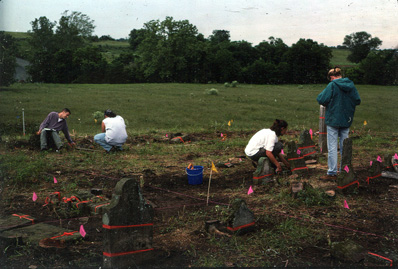 |
Crew members map and record grave markers prior to
removal. |
Fiegel's
initial investigations at the cemetery resulted in a consensus
determination of National Register eligibility. The cemetery
contains the remains of the Vardaman family and their
descendants who participated in the initial settling of
Kentucky. For example, John Vardeman is listed as a member of
the group(s) that blazed the Wilderness Trail. Thus, the family
made important contributions to the settlement of Kentucky in
the late 18th century. The cemetery's nine large, limestone slab
or table markers were thought to be a distinctive grave marker
type for the period between 1815 and 1850 in central and
south-central Kentucky. In addition, a gravestone with the
maker's name and city held promise for studying local stone
carving traditions. Finally, the cemetery contained data that
could shed light on mortuary practices during the 19th century,
demographic information, and forensic pathology.
The
general research issues for this site are in the realms of
biological anthropology, mortuary practices, and material
culture studies. The site was thought to present an
unprecedented opportunity to explore a 19th-century Kentucky
population through the analysis of human skeletal material.
Biological anthropology represents one of the newest and most
exciting research frontiers in archaeology, and data derived
from a variety of analytical techniques can be used to address
research questions concerning health status at both the
individual and population level. Another group of research
questions are related to deciphering the changing views of death
from religious, social, and economic perspectives in terms of
the mortuary treatment of the deceased.
The
material culture area focuses on artifacts associated with the
burials and includes the grave markers, burial containers
(coffins), and individual clothing and possessions. The nature
of the cemetery, particularly the number of marked and dated
graves, allows for precise temporal definition for coffins and
coffin hardware. To date, no systematic work has been completed
to develop a local or regional typology for these materials.
Material culture research also focuses on clothing-related and
personal artifacts. These materials will be used to discuss
burial practices and also hold the potential to provide dating
information for unmarked burials. Finally, studies of grave
markers focus on gravestone shape, style and decoration,
inscriptions, iconography, and individual makers, to explore
temporal stylistic variability as well as their representation
of changing views of death.
With
these general and specific research questions in mind, we
designed a data recovery plan to document the skeletal remains,
possessions, and burial containers of all residents of this
silent city. The initial work included establishing a site grid
and mapping the current site conditions.
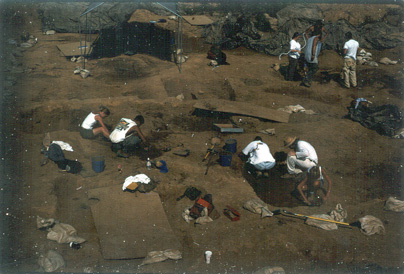 |
View of excavation under way. |
Following
this, we completed the documentation and removal of all grave
markers. The stones were individually recorded photographed,
tagged, and then moved by hand or mechanically lifted and placed
on wooden pallets for storage until reinterment. The next step
was mechanical stripping of the area within the fence and around
the cemetery perimeter; areas outside the cemetery fence were
stripped to document unmarked graves located outside the
cemetery boundary. At this point, the stripped area was cleaned
and all grave features were numbered and mapped; sixty-eight
possible graveshaft features were identified.
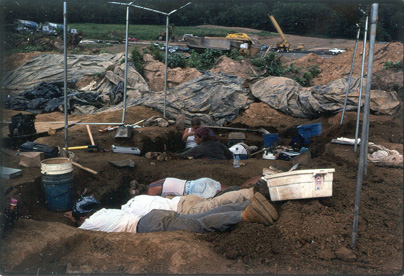 |
Field technicians excavating a burial. |
Each
identified burial feature was then hand excavated by teams of
three field technicians, one of whom had bioarchaeological
training. The human remains were uncovered and recorded in situ
using drawings and print and slide photography. Following
documentation, the remains were removed and transported to the
laboratory at the University of Kentucky.
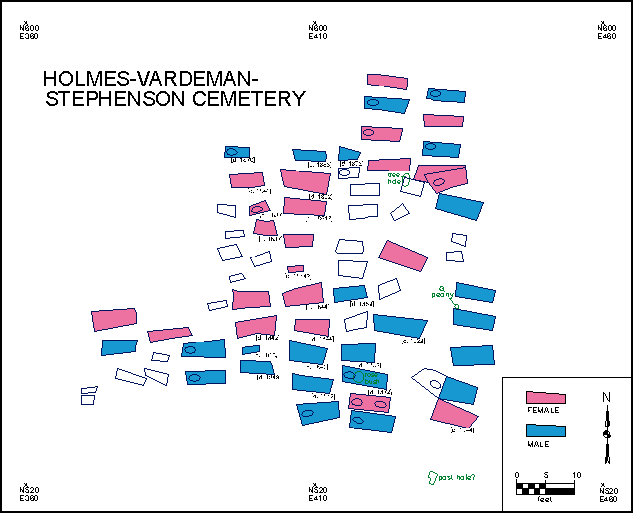 |
|
Cemetery site plan showing burials by gender
(pink=female; blue=male). |
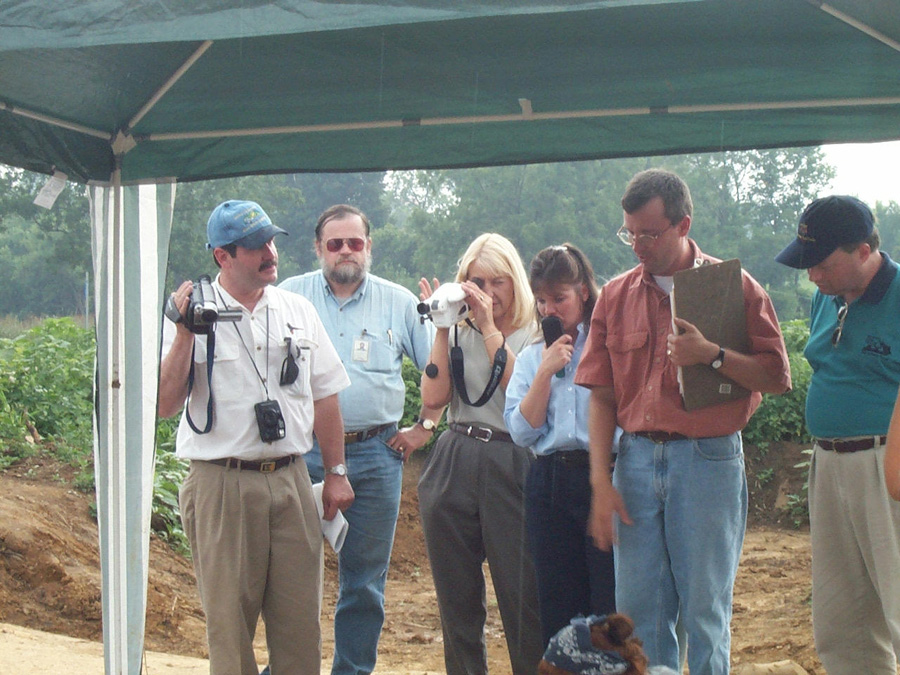 |
|
Project Director Shawn Phillips (second from right) and
United States Army Corps of Engineers Louisville
District Archaeologist Don Ball (second from left) talk
with several family members during their visit to the
site. |
Members
of the Vardeman and Holmes families were involved in all aspects
of the project including the development of the data recovery
plan, visitation to the cemetery during excavation, and meetings
at the laboratory facility to view and examine the remains and
witness the analysis process first hand. Family cooperation and
support was seen as critical for the success of this very
sensitive project. Family member Jane Holmes (2000) wrote that
"the professionalism that [the staff] displayed was
outstanding.... After visiting the site, I am much more
comfortable that the removal of the remains is being handled
appropriately."
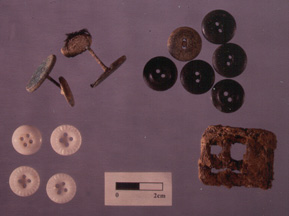 |
|
Personal artifacts, buttons, cufflinks, and buckle from
various burials. |
Analysis
included initial processing and cleaning of the remains and
artifacts and a host of special studies, as well as historical
research using a wide range of documentary materials. Human
osteological data collection and analysis was completed using
the Standards for Data Collection from Human Skeletal Remains (Buikstra
and Ubelaker 1994). The Standards provide detailed guidelines
for a broad range of essential skeletal and dental data
collection, including inventory of skeletal elements,
observations for the determination of age at death and
estimation of biological sex, observations on the primary and
secondary dentitions, cranial and postcranial metrical and
morphological observations, and observations of a variety of
pathological skeletal conditions. Special studies completed or
currently underway include stable isotope and trace element
analysis of both dental and skeletal remains and x-ray and CT
scans for both standard differential diagnosis analysis and
biomechanical analysis. We are also currently exploring a full
DNA analysis of the population of individuals from the cemetery.
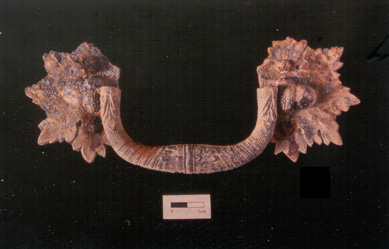 |
|
Decorative coffin handle from Burial # 41. |
The study
of the burial containers and personal effects is also nearing
completion. This work includes a full inventory and typology of
the coffin hardware with reference to documents such as
manufacturer's catalogs, identification of all coffin wood
remains, and cleaning, documentation, and interpretation of the
surviving textiles. These studies are being combined to create
full pictures of the coffins and interments in order to explore
burial practices and customs in central Kentucky. For example,
ethnographic and documentary research by Stone (1987:216) on
burial practices in south central Kentucky during the late 19th
and early 20th centuries suggests that the transition to
professional funeral services and undertakers was just beginning
in the 1880s and 1890s. Stone (1993:53) notes that "although
undertakers were burying some townspeople, the majority of rural
southeastern [and southcentral] Kentuckians continued to render
burial preparations for their fallen loved ones." Although metal
coffins were increasingly common across the US during this
period, they were still rare in rural areas. More typically, the
coffin maker would construct a wooden coffin, and fit it with
mass produced hardware including handles, coffin screws,
thumbscrews, viewing plates, and hinges. In most cases, the
deceased was buried in regular clothing, although specialty
burial garments were available from undertakers; likewise, while
embalming was fairly typical by the late 19th century, it was
still unusual in rural Kentucky.
With this
project background in mind, let us turn to several specific
examples of burials from the cemetery. Shawn Phillips has
provided the osteobiographies of two of the cemetery residents:
Lindsey Stephenson (1792 to 1870) and Samuel Holmes (1814 to
1872) (see Table 1). Osteobiographical analysis merges
historical and skeletal data in an attempt to better understand
the lifeways of the deceased. These men share significant life
histories that include being among the first generation of
settlers born west of the Appalachians, marrying daughters of
pioneers Morgan and Polly Vardeman, and owning and operating
successful farms into the industrial era. Lindsey and Samuel
also share prominent mortuary characteristics, like burial in
metal caskets and distinguished headstones.
In this
analysis, we question the factors that resulted in these men's
differential mortuary treatment. More specifically, we ask the
question - How can osteobiographical data inform the period that
spans pioneer life to the incipient industrial era in America's
past?
Skeletal
preservation for both men was excellent primarily due to
interment in metal caskets. Lindsey Stephenson's casket was an
interesting blending of a decorative cast iron top attached to a
wood framed, lead covered bottom, while Samuel Holmes's casket
was a full cast iron model. Textiles were also well preserved
due to the metal coffins; most of Lindsey Stephenson's burial
suit has been recovered as has portions of Samuel Holmes's
clothing.
General
observations for both individuals show stature equal to or
greater than the modern standard for US males of 69 inches, they
exceeded the life expectancy for the late 19th century of 49
years (Leavitt and Numbers 1997), and they experienced modern
health problems associated with old age, like advanced alveolar
resorption (receding gums) and diffuse osteoarthritis (see table
below).
|
Table 1. Osteobiographies.
|
| |
Lindsey Stephenson |
Samuel Holmes |
|
Observation |
parents: David and Edith (Logan) Stephenson |
parents: Samuel and Mary (Faulkner) Holmes |
|
Demography |
78 years - 1792 to 1870 |
58 years - 1814 to 1872 |
|
Childhood Health markers |
71", no porotic hyperostosis, LEH present |
69", no porotic hyperostosis, edentulous |
|
Paleopathology |
Articular fracture, active mastoid sinus infection,
advanced alveolar resorption |
Healed fractured ribs, early manifestation of spinal TB |
|
Cause of death |
Pneumonia |
Apoplexy or murder? |
|
Spouse |
Ann Vardeman; Ann Logan; Lucinda Stephens |
Eliza Vardeman |
|
Reproductive Fitness |
10 children (4 survived to adulthood), at least 30
grandchildren |
6 children (3 survived to adulthood), at least 6
grandchildren |
|
Occupation |
Farmer, surveyor |
Farmer, Master Mason |
|
Farm size |
328 acres - $10,700 (1860) |
580 acres - $12,000 (1860) |
|
Produce |
Wheat, rye, corn, oats, butter, wool (no tobacco)
|
Same as Lindsey, but also flax and cheese |
|
Livestock |
10 horses, 5 mules, 13 milk cows, 2 oxen, 24 "cattle,"
28 sheep, 23 swine |
11 horses, 45 mules, 12 milk cows, 4 oxen, 60 cattle, 25
sheep, 55 swine |
|
Slaves |
25 |
9 |
|
Place in Kentucky |
1st generation of Euro-American settlers born west of
the Appalachians |
|
Place in US |
Represent economically successful patriarchs born into a
minimalist agrarian society and died at the inception of
industrial America and consumer materialism |
Lindsey's
skeletal remains offer specific details of his childhood health,
adulthood, and cause of death. Lindsey's dentition was in a poor
state at the time of his death. He had lost nearly 60% of his
teeth, and of those that remained 30.8% were diseased. Lindsey's
few remaining teeth exhibit Linear Enamel Hypoplasia (LEH) a
condition that speaks to his childhood health. LEH represent
"lines of growth cessation" during childhood that are caused by
an extreme stress like infectious disease (Hillson1996). During
such disease episodes the body can be depleted of nutrients and,
in children, this often results in the cessation of growth in
the struggle to recover from the infection. When a child
survives the disease episode, normal growth resumes but LEH
leave a permanent lesion on the dentition. Thus, LEH are
significant markers of survival that demonstrate successful
adaptation to stresses in the environment. Stature is a general
measure of adaptation during growth and development (Larsen
1997). The fact that Lindsey grew to nearly six feet tall,
greater than the contemporary standard for American men, further
demonstrates that he not only successfully adapted to the
disease environment but also achieved his full genetic
potential. Lindsey's skeletal remains also provide insights to
his cause of death. Radiographic analysis demonstrates an active
mastoid sinus infection (build up of active sclerotic bone) at
the time of death. Cranial sinus infections are indicators of
upper respiratory disease, which if not the cause of death,
often act as opportunistic infections when the immune system is
compromised and contribute to the cause of death (Roberts and
Manchester 1995). The sinus lesions concur with Lindsey's cause
of death, which was listed as pneumonia in the 1870 Federal
Census death schedules.
Samuel
Holme's skeletal remains provide equally compelling insights to
his life. Samuel was edentulous and buried with gold plated
false teeth. Tooth extraction was a popular treatment for tooth
decay among late 19th- century dentists once anesthesia became
widely available (Magner 1992). From this we can surmise that
Samuel had significant tooth decay problems and survived the
concomitant high pathogen burden until the diseased teeth were
extracted (Hillson 1996). Samuel reached a height of 69 inches,
the average for contemporary American men. This indicates, as it
did for Lindsey, that Samuel achieved his genetic potential
despite the infectious disease environment he experienced as a
child. Samuel's skeletal elements also provide a key to his
cause of death. Samuel lived to 58, which exceeded the life
expectancy at the close of the 19th century. Samuel's vertebrae
exhibit lesions that suggest an early tuberculosis infection.
Tuberculosis can infect any part of the body, and involves the
skeletal system in only 12% of active cases (Auferheide and
Rodriguez-Martin 1998). Samuel Holmes' obituary offers two
possible explanations for his death (Interior Journal:
8-9-1872). While returning from a trading trip from the west,
Samuel was found at a train stop in Rushville, Indiana, in a
disoriented state. Although foul play was suspected, it is
unlikely since Samuel carried over a thousand dollars in cash on
his person. The other suggested possibility was a stroke, which
seems a more parsimonious explanation. Tuberculosis is likely to
have contributed to his death since the disease commonly affects
the brain (Purtillo and Purtillo 1999). Whether Samuel died of a
stroke or if his TB infection contributed to that attack is
unknown. It is clear, however, that both Samuel and Lindsey
suffered mortal conditions, tuberculosis and pneumonia, that
counted among the leading causes of death for the time (Leavitt
and Numbers 1997).
Lindsey
Stephenson and Samuel Holmes' biohistories are remarkable in
that they reflect a generation that witnessed the transition
from a minimalist pioneer to an industrial economy. Both men,
for example, were born into first generation pioneer families, a
time when homesteads were firmly established, land was
plentiful, and the population explosion had yet to occur
(Harrison and Klotter 1997). In this context, they achieved
their genetic potential in stature and lived beyond the current
life expectancy despite an epidemiological environment of mortal
diseases for which there were no curative medicines or
preventive measures. The differential mortuary practice evident
in their burials is also reflective of a unique moment in
American history. Morgan Vardeman received minimalist mortuary
treatment that was in line with the rest of his immediate family
buried during the 1840s, and his adult grandsons (Lindsey and
Samuel's sons) are buried with inexpensive mourning symbols with
less prominent headstones or only a fieldstone to mark their
grave. From this analysis we suggest that patriarchs of Lindsey
and Samuel's generation inherited the prosperity established by
their pioneer parents and were buried with adornments fitting of
the emergent consumer materialism of the industrial era. This
lucky generation is sandwiched between the hardships of
pioneering land settlement and the economic strife of mass
immigration and the accompanying rise of wage labor experienced
by their children and grandchildren. This discussion of two
important residents of the cemetery has provided a brief idea of
the type of work that is underway for the entire cemetery
population.
The final
stage of work for the project involves laying out a new cemetery
that will be a close reproduction of original. All remains will
be reintered in their original spatial orientation and all grave
markers will be replaced following conservation and repair. We
are currently developing a list of objects to permanently curate
that includes a small sample of personal effects, coffin
hardware, textiles, and forensic skeletal samples. With the
completion of this work, we will be able to return the cemetery
to the family members in better condition that at the beginning
of the project and having spurred many of these folks in their
appreciation of their family's past. In this sense, we will have
renewed and given voice to the residents of this silent city.
REFERENCES CITED
Aufderheide, Arthur C., Conrado Rodriguez-Marti, and Odin
Langsjoen
1998 The Cambridge Encyclopedia of Human Paleopathology.
Cambridge: Cambridge University Press.
Bell,
Edward L.
1990 The Historical Archaeology of Mortuary Behavior: Coffin
Hardware from Uxbridge, Massachusetts. Historical Archaeology
24(3):54-78.
Buikstra,
Jane E. and Douglas H. Ubelaker, eds.
1994 Standards for Data Collection from Human Skeletal Remains.
Fayetteville, AR: Arkansas Archaeological Survey Research Series
No. 44.
DiBlasi,
Philip
2000 Personal Communication.
Fiegel,
Kurt
2000 Personal Communication.
Grauer,
Anne L., ed.
1995 Bodies of Evidence: Reconstructing History Through Skeletal
Analysis. New York: John Wiley & Sons.
Klotter,
James C. and Lowell Hayes Harrison
1997 A New History of Kentucky. Lexington: University of
Kentucky Press.
Hillson,
Simon
1996 Dental Anthropology. Cambridge: Cambridge University Press.
Larsen,
Clark Spencer
1999 Bioarchaeology: Interpreting Behavior from the Human
Skeleton. Cambridge: Cambridge University Press.
Little,
Barbara J., Kim M. Lanphear, and Douglas W. Owsley
1992 Mortuary Display and Status in a Nineteenth-Century
Anglo-American Cemetery in Manassas, Virginia. American
Antiquity 57(3):397-418.
Leavitt,
Judith Walzer and Ronald L. Number, eds.
1997 Sickness and Health in America: Readings in the History of
Medicine and Public Health. Madison: University of Wisconsin
Press.
Magner,
Lois N.
1992 A History of Medicine. New York: Marcel Dekker Press.
Morgan,
David
2000 Letter to Donald Ball dated 3/31/2000.
Poirier,
David A. and Nicholas F. Bellantoni, eds.
1997 In Remembrance: Archaeology and Death. Westport, CT: Bergin
and Garvey.
Powell,
Mary Lucas
2000 Personal Communication.
Roberts,
Charlotte and Keith Manchester
1997 The Archaeology of Disease. Ithaca: Cornell University
Press.
Saunders,
Shelly, and D. Ann Herring, eds.
1995 Grave Reflections: Portraying the Past Through Cemetery
Studies. Canadian Scholars' Press Inc., Toronto.
Wood,
Lynda S. and Janet Young
1998 Historical Skeletal Remains for Dundas County, Ontario: A
Cautionary Tale Concerning Individual Identification. Northeast
Historical Archaeology 27:51-62.
|